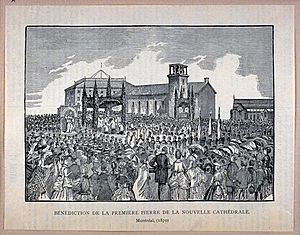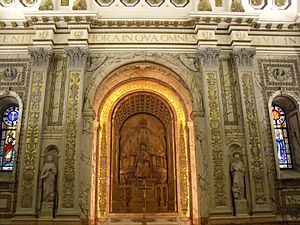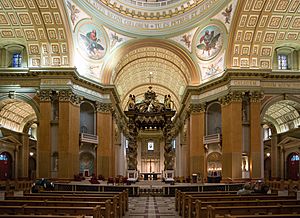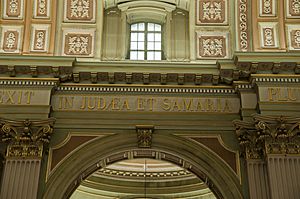Mary, Queen of the World Cathedral facts for kids
Quick facts for kids Mary, Queen of the World Cathedral |
|
|---|---|
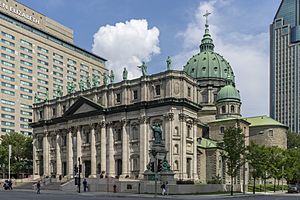 |
|
| 45°29′57.10″N 73°34′6.10″W / 45.4991944°N 73.5683611°W | |
| Location | 1085 De la Cathédrale street Montreal, Quebec H3B 2V3 |
| Denomination | Roman Catholic |
| History | |
| Status | Cathedral, minor basilica |
| Architecture | |
| Functional status | Active |
| Style | Renaissance, Baroque |
| Groundbreaking | 1875 |
| Completed | 1894 |
| Specifications | |
| Length | 101.5 metres (333 ft) |
| Width | 45.72 metres (150.0 ft) |
| Height | 76.8 metres (252 ft) (cupola) |
| Administration | |
| Archdiocese | Montreal |
| Metropolis | Montreal |
| Province | Montreal |
The Mary, Queen of the World Cathedral is a very important church in Montreal, Quebec, Canada. It is also known as the Mary, Queen of the World and St. James the Great Cathedral. This church is a minor basilica, which means it has special ties to the Pope. It is the main church for the Roman Catholic Archdiocese of Montreal.
This cathedral is the third largest church in Quebec. Only Saint Joseph's Oratory (also in Montreal) and the Basilica of Sainte-Anne-de-Beaupré are bigger. The building is about 101 meters (333 feet) long and 46 meters (150 feet) wide. Its highest point, the dome, reaches 77 meters (252 feet) tall.
You can find the cathedral in downtown Montreal at 1085 Cathedral Street. It is close to the Bonaventure metro station and Central Station. The cathedral and its connected buildings are a big part of Place du Canada and Dorchester Square.
Contents
History of the Cathedral
The idea for this cathedral came from Mgr. Ignace Bourget. He was the second bishop of Montreal. He wanted to build a new church because the old Saint-Jacques Cathedral had burned down in 1852.
Bishop Bourget decided to build a smaller copy of Saint Peter's Basilica in Rome. This was a way to show his strong Catholic faith. At the time, there was a friendly competition with other religious groups in Montreal. These groups preferred a different style of church building.
The first architect, Victor Bourgeau, thought it would be too hard to copy St. Peter's on a smaller scale. But Bishop Bourget was determined. He even sent Canadian soldiers, called Zouaves, to help defend the Pope's lands in Italy. Their names are written in gold inside the cathedral. Their motto was: "Love God and go your way."
Work on the cathedral started in 1875. The church was officially opened in 1894. It was first called Saint James Cathedral. This was after Saint James the Great, who was the patron saint of the area. At that time, it was the biggest church in Quebec.
In 1919, Pope Benedict XV gave it the special title of a minor basilica. Later, in 1955, Pope Pius XII renamed it to Mary, Queen of the World. This was at the request of Cardinal Paul-Émile Léger. The Pope had given Mary this title in 1954.
Between 1955 and 1960, the cathedral was repaired and updated. On March 28, 2000, it was named a National Historic Site of Canada. This means it is a very important place in Canadian history.
Since 2003, parts of the cathedral's outdoor area and entrance have been rebuilt. In 2005, the statue of Bishop Ignace Bourget outside was cleaned and fixed.
Inside the Cathedral: Design and Art
The cathedral's design is inspired by famous churches in Europe. It has many beautiful features inside.
Special Chapels
The Baptistery
This small chapel is used for baptism ceremonies. A baptism is a special religious event. The font, where water is used, is made of marble. It sits on a stucco crucifix carved by Louis-Philippe Hébert.
Bishops' Burial Chapel
This chapel is where bishops are buried. It was finished in 1933. You can find it on the east side of the church, near the middle. The tomb of Mgr. Bourget, the bishop who ordered the cathedral, is in the center. His remains were moved there in 1933.
The walls and floors of this chapel are made of marble from Italy. There are also beautiful mosaics. A bronze plaque above the altar shows St. Peter's Basilica in Rome.
In 2005, a second chapel was built next to the first one. This was needed because there wasn't enough space for more bishops to be buried. It has 15 new burial spots.
Chapel of the Assumption
This chapel is also called the Marriage Chapel. It is on the west side of the church. It has a beautiful wooden altarpiece decorated with gold. This altarpiece frames a painting of the Assumption of the Virgin Mary. It was made around 1635 in Switzerland.
In 1957, Cardinal Paul-Émile Léger made this chapel available to the Order of Malta. The stained-glass windows in this chapel tell stories about this Order.
The Ciborium
Under the large dome, above the main altar, is a beautiful structure called a ciborium or baldaquin. It has twisting columns. This ciborium was made in Rome in 1900 by Joseph-Arthur Vincent. It is a copy of the famous 'baldacchino' in St. Peter's Basilica, which was created by Gian Lorenzo Bernini.
It is made by hand from red copper and gold leaf. Angels and other decorations were carved between 1910 and 1911 by Olindo Gratton. This amazing piece was a gift to the cathedral from the Sulpicians.
The Great Organ
The cathedral's organ was built by Casavant Frères. It was first played on September 22, 1893. Back then, it had 56 different sounds, called stops.
In 1951, the organ needed repairs. It was decided to rebuild the whole instrument. Casavant Frères did the work again and added 20 more stops.
From 1995 to 1996, the organ was restored by Guilbault-Thérien. A few more additions were made. Now, the organ has a total of 93 stops.
Paintings and Stories

Along the sides of the main hall, called the nave, and in the transept, there are paintings. These paintings show important historical events from the early days of Montreal. Montreal was once called Ville-Marie. There are nine paintings, with three empty spaces for more.
Here are some of the stories told in the paintings:
- A painting of Colonel Athanase de Charette, who led the Papal Zouaves from Montreal.
- Marguerite d'Youville singing during a fire that destroyed her hospital in 1765.
- Marguerite Bourgeoys teaching Indigenous students in 1694.
- The story of Jean de Brébeuf and Gabriel Lalemant, missionaries who faced challenges.
- Father Barthélemy Vimont celebrating the first Mass in Montreal in 1642. Paul de Chomedey, Sieur de Maisonneuve and Jeanne Mance, who helped found Montreal, are in this painting.
- A painting showing people praying in Paris in 1641 for the success of their plan to found Ville-Marie.
- The first Mass celebrated at Rivière-des-Prairies by Father Denis Jamet in 1615. Samuel de Champlain, who founded Quebec City, is also in this painting.
- The story of Nicolas Viel and his student Ahuntsic during a difficult journey.
- Jeanne Mance and the nursing sisters helping a sick child at Montreal's first hospital.
Statues and Saints
In the back part of the church, called the apse, there is a statue of Mary, Queen of the World. She is the patron saint of the cathedral. This statue was made by Sylvia Daoust.
Like St. Peter's Basilica, the cathedral has statues of saints on its roof. These are the patron saints of 13 Montreal parishes that helped pay for the cathedral. The statues were carved by Olindo Gratton between 1892 and 1898.
- Saint Anthony of Padua
- Saint Vincent de Paul
- Saint Hyacinth
- Saint Thomas Aquinas
- Saint Paul
- Saint John
- Saint James the Greater (the patron of this cathedral)
- Saint Joseph
- Saint John the Baptist
- Saint Patrick
- Saint Ignatius of Antioch
- Saint Charles Borromeo
- Saint Francis of Assisi
Near the church, there is also a monument dedicated to Bishop Ignace Bourget.
Golden Texts and Meanings
You will see many texts written in golden letters inside the cathedral. Since the church was first dedicated to Saint James the Greater, many of these Latin texts talk about his life.
Texts in the main hall (nave) include:
- On the east side: "He [James] is one of the three Apostles whom the Savior loves the most. In Judea and Samaria he converts many to the Christian faith."
- On the west side: "He also converts some people in Spain, in Jerusalem he is condemned to death. He is the first of the Apostles that bears witness to Jesus with his blood."
The texts in the transept (the cross-shaped part of the church) are from the Bible (Matthew 20:22–23). They tell the story of James and John asking Jesus to sit beside him in his Kingdom.
- On the east side: "And Jesus, answering, said: You know not what you ask. Can you drink the chalice that I shall drink? They said to Him: We can. And he told them:"
- On the west side: "My chalice indeed you shall drink, but to sit at my right or left is not for me to grant, [these places] belong to those for whom they have been prepared by my Father."
Two other texts, from Matthew 16:17–19, talk about Saint Peter, who was the leader of the Apostles. You can also find these texts in St. Peter's Basilica in Vatican City.
- Inside the cupola: "You are Peter and upon this rock I will build my Church. And the gates of hell shall not prevail against it. And I will give you the keys of the Kingdom of Heaven. "
- In the chancel and apse: "And whatsoever you shall bind upon earth, it shall be bound also in Heaven: And whatsoever you shall loose on earth, it shall be loosed also in Heaven. Feed my sheep."
- At the bottom of the cupola: This text is split into four parts. It is from the Bible (Revelation 4:8) and praises God: "Holy, Holy, Holy, the Lord, who is, who was, and who is to come."
See also
 In Spanish: Catedral basílica de María Reina del Mundo y de Santiago (Montreal) para niños
In Spanish: Catedral basílica de María Reina del Mundo y de Santiago (Montreal) para niños
- Roman Catholic Marian churches
- List of cathedrals in Canada
- List of tallest domes



